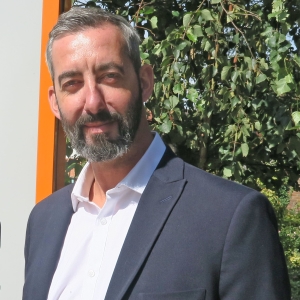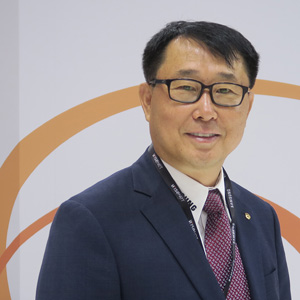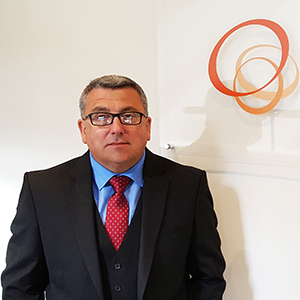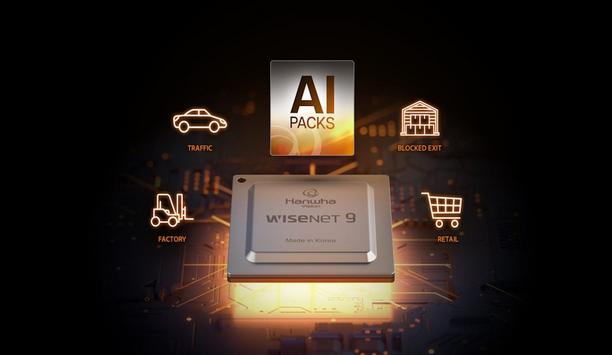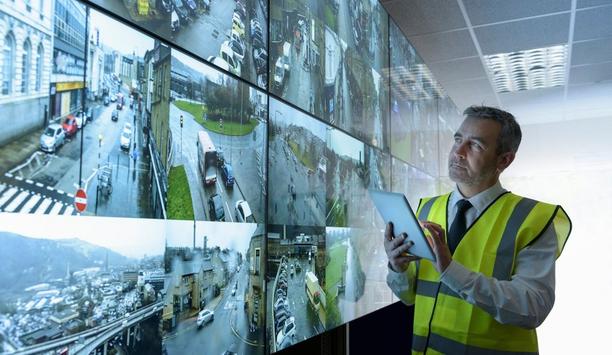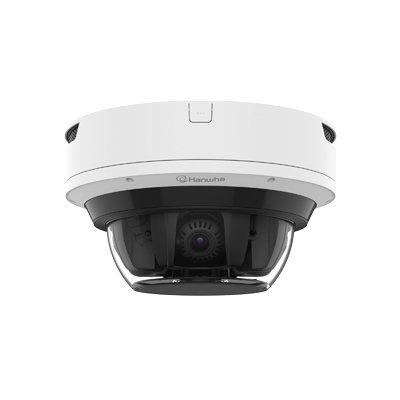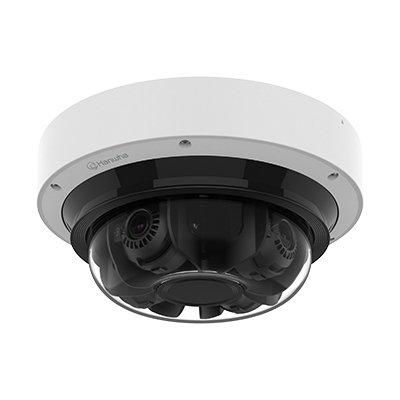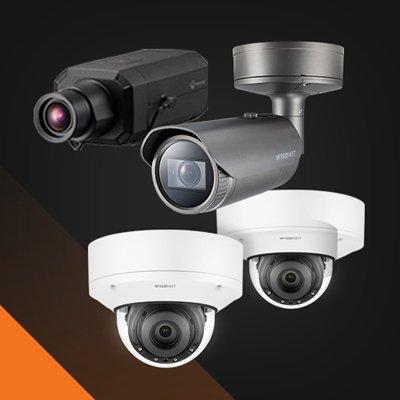Hanwha Vision Europe - Experts & Thought Leaders
Latest Hanwha Vision Europe (formerly Hanwha Techwin Europe) news & announcements
The future of security requires smarter, more efficient and secure solutions, and Hanwha Vision is helping to drive this transformation with the launch of its most advanced AI-powered System on a Chip (SoC), Wisenet 9. After nearly four years of extensive research and testing, Wisenet 9’s advanced features help elevate our cameras into an AI-driven era, setting a new standard for performance, accuracy, and security. Unmatched clarity “With Wisenet 9, you can count on the superior image quality that delivers the best possible video in the toughest environments, as well as the accuracy of the AI-generated data, whether statistical or event-driven,” states John Lutz Boorman, Head of Product and Marketing at Hanwha Vision Europe. AI revolution at the Edge Wisenet 9’s enhanced edge AI capabilities are essential in this innovation era, where the volume and complexity of security threats demand real-time, accurate analysis. By elevating edge-device performance, AI empowers systems to quickly analyse vast amounts of video data and discern crucial patterns and anomalies. A key differentiator driving this transformation is the two Neural Processing Units (NPUs), which have improved inference performance three-fold compared to Wisenet 7, the previous SoC generation. While one NPU handles image processing, the other focuses on object detection and advanced analytics. This dual NPU concept was introduced to ensure video quality and analytics have independent resources, preventing one function from impacting the performance of the other. Unveiling hidden details Wisenet 9 uses AI to analyse visual data with greater precision. By leveraging a powerful NPU, the system moves past traditional image processing to extract critical information, unlocking previously unseen details with remarkable clarity in tough environments. This enhanced visual intelligence is achieved through a suite of sophisticated AI features, including AI-based extreme Wide Dynamic Range, AI-powered noise reduction, alongside image enhancements. Combined, these technologies deliver exceptional clarity, even under the most challenging conditions. The AI-driven image enhancement, powered by an independent NPU, ensures that every detail, no matter how subtle, is captured and analysed. AI efficiency redefined The H.265 codec provides high video quality with optimised bandwidth AI is powerful, but it can also be resource-intensive. Wisenet 9 flips that script. It’s not just smart, it’s efficient - optimising every aspect of its operation.By intelligently reducing noise, Wisenet 9 achieves a remarkable level of efficiency in data volume reduction, resulting in significantly reduced bandwidth consumption and storage requirements. This core efficiency is further bolstered by the latest H.265 compression technology. The H.265 codec provides high video quality with optimised bandwidth, ensuring reliable, real-time video processing and transmission - critical for uninterrupted 24/7 security. Furthermore, this optimised H.265 support enables consistently high performance in demanding environments, essential for system stability, and streamlines data management in cloud environments, efficiently controlling storage and transfer costs. Seamless integration Wisenet 9’s H.265 codec, aligned with current industry standards and ONVIF profiles, ensures broad hardware compatibility and seamless integration with your existing security infrastructure and provides a dependable foundation for long-term system reliability. Beyond this, Wisenet 9 leverages AI for advanced analytics. Its enhanced AI technology provides detailed attribute analysis, including colour, bag, face mask, glasses, age, and gender, along with other key analytics like people and vehicle counting, slip and fall detection, crowd detection, heatmap, queue management, and more, enabling faster and more informed decision-making. Smart surveillance tech To further amplify its capabilities, Wisenet 9 incorporates several key technologies that power the next generation of efficiency, including: Re-Identification RE-ID technology is a deep learning-based approach to matching visual identities across non-overlapping camera views. RE-ID extracts feature vectors representing unique visual attributes, enabling video management systems to recognise and track individuals even with changes in appearance or conditions. For example, it can identify a person entering a building with an orange jacket and later recognise the same person leaving with the jacket unzipped and a hat, across different cameras. Dynamic Privacy Masking This AI-based feature efficiently safeguards biometric personal data, ensuring compliance with privacy regulations. Wisenet 9 offers flexible masking options, including both opaque and mosaic masking, allowing users to tailor privacy protection to their specific needs and preferences. Widening horizons with expandable AI Wisenet 9 has been engineered with unparalleled AI capabilities to recognise security demands Recognising that security demands are as diverse as the industries they serve, Wisenet 9 has been engineered with unparalleled AI capabilities. This empowers users to tailor their security systems. § AI Packs: Wisenet 9 is compatible with AI Packs (Traffic, Retail, Factory), designed to deliver actionable insights specific to various sectors. AI Sound Classification AI-based sound classification enables rapid detection and directional awareness of critical events like gunshots, glass breaks, and screaming, to enhance situational awareness. Hanwha vision open platform Wisenet 9 empowers users to create customised security solutions by providing the flexibility to tailor their systems with custom applications for video analytics, storage, and other functionalities. Improved end-to-end protection Wisenet 9 significantly enhances end-to-end protection by building upon the robust security foundation of Wisenet 7. It inherits essential features like Secure Storage, OS, and Boot, which protect critical chipset data and prevent unauthorised software execution. Moreover, the inclusion of a FIPS 140-3 Level 3 elevates security to an exceptional standard. This certification guarantees that the chipset adheres to rigorous security protocols, assuring users of comprehensive data protection.
The Security Industry Association (SIA) has announced its new Board of Directors chair-elect and presented its new and returning members to the SIA Board of Directors on April 1 at The Advance, SIA’s annual membership meeting, and the following Board of Directors meeting during ISC West. The SIA Board of Directors ratified the selection of Mike Mathes, executive vice president (EVP), western operations at Convergint and former treasurer of the SIA Board of Directors, as SIA chair-elect. Three new voting members Additionally, the board ratified the selection of three new voting members of the Board of Directors to serve two-year terms from 2025 to 2027: Min Kyriannis, chief executive officer and co-founder, AMYNA Systems Bobby Louissaint, head of technical partnership engagement, Global Systems Services and Technology, Meta Don Young, EVP and chief operating officer, ADT. Six individuals in the second two-year term Six individuals were confirmed to serve a second two-year term: Charles Burns, director of commercial facilities, Intelligent Security Systems Tom Cook, EVP of sales and operations, North America, Hanwha Vision Tara Dunning, vice president of global security, Wesco Dave Ilardi, senior vice president and president of the Americas, Allegion John Nemerofsky, chief operating officer, SAGE Integration Steve Reinharz, founder and chief executive officer, RAD SIA Executive Committee for 2025 Following the ratification, the SIA Executive Committee for 2025 includes: Chair: Scott Dunn, senior director of business development, Axis Communications Chair-Elect: Mike Mathes, EVP of Western Operations, Convergint Secretary: Dave Ilardi, senior vice president and president of the Americas, Allegion Treasurer: John Nemerofsky, chief operating officer, SAGE Integration At-Large Officer: Tara Dunning, vice president of global security, Wesco Immediate Past Chair: James Rothstein, operating partner, Lee Equity Partners SIA’s Government Relations Committee “SIA is grateful to have the guidance of a highly regarded, committed and accomplished Board of Directors. On behalf of SIA and our members, we would like to congratulate our new SIA Chair-Elect, Mike Mathes, as well as the 2025 Executive Committee and our new and returning board members. These inspiring, experienced pioneers are helping to drive innovation at SIA and across the industry,” said SIA CEO Don Erickson. “We also thank outgoing board members Jonathan Aguila, whose vision helped lead to the creation of SPARC, SIA’s technical end-user community, and Holly Borgmann, who has played an instrumental leadership role as vice chair of SIA’s Government Relations Committee and as a member of the Endowment Committee – for dedicating their time and expertise over the course of their impactful service.” Spectrum of interests in the security industry The SIA Board of Directors is comprised of industry professionals representing a broad spectrum of interests in the security industry. At The Advance 2025, attendees also recognised the accomplishments and contributions of industry pioneers; presented its annual membership awards, the SIA Member of the Year Award, Sandy Jones Volunteer of the Year Award, Committee Chair of the Year Award and Standards Service Award; reviewed SIA official association business; exchanged market intelligence for the year ahead; and enjoyed a dynamic presentation from special guest speaker Sonny Tai, co-founder of Actuate.
Thames Valley Police worked with local authorities to improve CCTV coverage, cut costs, and boost efficiency. It’s made public spaces safer and ensured long-term, reliable monitoring across the region. Thames Valley Police is the largest non-metropolitan police force in England and Wales, covering 2,218 square miles and a population of 2.42 million people. Its jurisdiction includes multiple towns, city centres and council areas across the three counties of Berkshire, Buckinghamshire and Oxfordshire. Setting a long-term vision for public space CCTV Public space CCTV is vital in deterring and detecting crime across the Thames Valley Public space CCTV is vital in deterring and detecting crime across the Thames Valley. However, significant pressure on local authority budgets has made it increasingly difficult for councils to provide public space CCTV. There was real jeopardy that financial constraints would result in unmaintained systems, with limited or no real-time monitoring. A fresh approach was needed, so the Thames Valley CCTV partnership between Genetec™ and Hanwha Vision was formed. The first major challenge was securing funding to overhaul several local authorities’ ageing systems, which were proving increasingly expensive to upgrade and maintain. The second was to manage the ongoing costs of staffing control rooms to ensure the long-term sustainability of monitored CCTV across the Thames Valley. Ownership and monitoring of public space CCTV Ambitious plans were devised to pool resources and replace many disparate systems with one police-owned system that could extend across multiple authorities. In effect, the aim was to transfer the ownership and monitoring of public space CCTV from local authorities to dedicated Thames Valley Police control rooms. It would be led by the Thames Valley Police & Crime Commissioner (PCC) Matthew Barber, collaborating with any local authority who chose to participate. It was a feat that had never been attempted in the UK on this scale that held the potential to drive efficiencies and enhance CCTV provision in areas it might otherwise have deteriorated. Ongoing commitment and investment “CCTV is an important part of community safety; benefitting police and local communities in helping to deter crime and antisocial behaviour, identify offenders and support prosecutions." "Ongoing commitment and investment enables high quality, consistent and sustainable CCTV provision now and into the future”, explains Matthew Barber, PCC, Thames Valley. Centralisation creates area-wide visibility and control Several control rooms in the Thames Valley, like Windsor & Maidenhead, had implemented Genetec Security Centre Several control rooms in the Thames Valley, such as Windsor & Maidenhead, had already implemented Genetec Security Centre and were very happy with its operation. Furthermore, as an open platform video management system, it could minimise costs by supporting a phased unification or “takeover” of existing systems across the Thames Valley. Finally, its hybrid cloud architecture provided Thames Valley with maximal flexibility to leverage any combination of cloud or on-premises infrastructure according to Name Thames Valley Police Industries Public Safety Location Thames Valley, United Kingdom Products Genetec Security Centre; Genetec Cloud Services; Federation Technology Partners Hanwha Vision Channel Partners CDS Systems what made sense for each application and location. This made it the obvious choice on which to standardise. Range of multidirectional AI-enabled cameras Following a competitive tender, Thames Valley chose CDS Systems to implement its proposed solution. This would be built on Genetec Security Centre and incorporate a range of multidirectional AI-enabled cameras from Hanwha Vision. A key driver in the decision was the high levels of commitment shown by all three parties to cybersecurity. Another was the recognition that the system design and technology selection could ensure a cost-effective implementation that could continue to evolve in line with the needs of its users. Integration between Genetec and Hanwha Vision technology Legacy cameras were retained and reused to maximise the return on existing investment wherever possible “We urgently needed to improve the quality of CCTV, enhance collaboration, and drive efficiencies for all partners. The respective capabilities and seamless integration between Genetec and Hanwha Vision technology was the optimal way of meeting Thames Valley’s requirements,” says Sam Thomas, CDS Systems. Phase one of the deployment involved CDS taking over an existing control room in Milton Keynes, replacing the legacy analogue infrastructure with a modern IP backbone. It then installed Genetec Security Centre to establish one platform through which officers could smartly interact with all incoming video feeds. Legacy cameras were retained and reused to maximise the return on existing investment wherever possible. A second Genetec workstation was also set up inside Slough Police Station, allowing officers to rapidly review footage for improved community response. Hanwha Vision’s AI-enabled multidirectional cameras CDS then introduced Hanwha Vision’s AI-enabled multidirectional 4k cameras to improve CCTV coverage and quality in public spaces. Each of these cameras incorporates up to five cameras in one device for wide-area surveillance, which would previously have required several separate devices, simplifying installation and resulting in significantly less associated cabling and infrastructure. They also provide powerful AI analytics, including accurate object detection and classification, to enable forensic search and save operators' time when responding to incidents. For example, identifying and establishing the movement of specific people or vehicles based on attributes such as vehicle type. Thames Valley CCTV partnership Phase two will see four additional control rooms in Oxfordshire merged into a single hub Phase two will see four additional control rooms in Oxfordshire merged into a single hub inside Abingdon Police station, also built on the Genetec Security Centre. This and the control room in Milton Keynes will be interlinked, adding further resilience as each site will be able to act as a fallback for the other. At this point, there will be a dedicated team of eighteen staff responsible for monitoring CCTV and enhancing CCTV for all participating communities in the Thames Valley CCTV Partnership. Innovative and cost-effective solutions “The CCTV Command Suite enabled by CDS, Genetec and Hanwha Vision has improved our workflows beyond recognition, enabling staff to quickly review and package evidence for frontline officers or more complex investigations. It has received several plaudits from officers for its ease of use,” says Jason Owen, CCTV Operations Manager, Thames Valley Police. “This collaboration between Thames Valley Police, Genetec, CDS Systems, and Hanwha Vision showcases the power of partnership in driving innovative, cost-effective solutions that improve public safety,” says John Boorman, Head of Product and Marketing at Hanwha Vision Europe. “Our AI-enabled cameras are designed to reduce false alarms and streamline operations, ensuring teams can focus on real incidents and drive efficiency across their monitoring.” Efficiency, at a lower cost All CCTV operators are civilian police staff vetted to the same clearance levels as sworn-in officers Pooling resources and transferring ownership to the police has brought about significant cost efficiencies for participating authorities, while also enhancing the quality and reliability of public spaces CCTV. Just as importantly, it has dramatically improved the police’s direct access to quality video evidence. Unlike in a traditional council-run control room, all CCTV operators are civilian police staff vetted to the same clearance levels as sworn-in officers. This means they have full access to Thames Valley’s suite of police databases and reporting software packages. They are better equipped to rapidly report incidents, support front-line officers, and communicate effectively with investigators as a result. On average, it handles between 300 – 500 incidents a month and has substantially increased the number of successful requests for supporting footage. “We’ve immediately seen the benefit of our investment in equipment and CCTV operators, with the police now much better equipped to deter and detect crime across the Thames Valley,” adds Barber. A solid platform for further improvements Control room operators’ intuition will always be the driving force that brings results Looking forward, Thames Valley has plans to use the Genetec platform to connect its people and mobile surveillance assets back to its control rooms for better cross-force interaction. Genetec Federation as a Service is already allowing live and recorded video to be shared with officers in the field. Soon it will also be extended to ensure video from police CCTV vans and drones is immediately available in the control room. In both cases this is achieved without complex network configuration, requiring only an internet connection. It is also at the beginning of its journey of fully realising the value of the AI-equipped Hanwha Vision cameras specified by CDS. Control room operators’ intuition will always be the driving force that brings results, but AI is freeing them up to do what they do best by saving time on routine monitoring and searches. Cost savings, resilience, and efficiencies Finally, talks continue that would see the addition of further control rooms across the Thames Valley to the Thames Valley CCTV Partnership. Having proven the model, would allow it to scale operations further to deliver even greater cost savings, resilience, and efficiencies. “We’re proud of what we’ve achieved to date but have no intention of resting on our laurels. The foundations we’ve established will ensure continued high-quality, consistent, and sustainable CCTV provision for our communities,” concludes Owen.
Insights & Opinions from thought leaders at Hanwha Vision Europe
Environmental concerns and ‘green’ initiatives have been gaining steam recently with increasing attention to issues, such as climate change and the drive to ‘net zero’ emissions. Sustainability has not historically been a big concern in the physical security market, but the times are changing. We asked this week’s Expert Panel Roundtable: How can the security industry be more environmentally friendly and contribute to sustainability?
Here’s a news flash: 2022 will be a pivotal year for the security industry. As we enter the new year, continuing change is a safe prediction for any fast-moving, technology-driven marketplace. Recent history confirms the ability of the security industry to shift and adapt to changing conditions and to provide an ever-expanding menu of technology solutions to make the world a safer place. Given that the new year will bring change, what will that change encompass? More to the point, what should it encompass? We asked this week’s Expert Panel Roundtable: What is the biggest change you would like to see within the security industry in 2022?
Qumulex is a new startup with a mission to provide physical security integrators a transition path to embrace the technology of the cloud and a subscription-based business model. Qumulex’s products seek to provide capabilities to embrace the cloud without an integrator having to turn their back completely on the ‘transactional revenue’ of installing new systems. As the transition happens, Qumulex offers a product line that supports any mix of systems from on-premises to the cloud. The flexible deployment model – enabling a cloud installation, an on-premise installation or any combination – is one of the ways Qumulex seeks to differentiate itself in the market. Installing fully on-premise system The Qumulex cloud-based platform uses a gateway device located on-premises to which local cameras are connected The system is designed so that an integrator can install a fully on-premise system and then later ‘flip a switch’ and transition to a cloud model, says Tom Buckley, VP Sales and Marketing. The Qumulex initial 1.0 system launch is currently entering its final beta test. Full commercial availability is expected in the first quarter of 2020, which the company will highlight in a bigger 20x20 booth at ISC West next year. The Qumulex cloud-based platform uses a gateway device located on-premises to which local cameras are connected. Ensuring cybersecurity, the gateway provides a ‘firewall’ of sorts to avoid any cybersecurity threat from entering an enterprise through a vulnerable IP camera. The system is designed to be ‘cloud-agnostic’ and to work with any public or private cloud, using Docker software and ‘containers,’ a standard unit of software that packages code and all its dependencies so an application runs quickly and reliably from one computing environment to another. At launch, the Qumulex system will use the Google cloud. Greater situational awareness The open platform approach will enable users to assemble best-of-breed solutions Another point of differentiation for the new platform is a unified access control and video surveillance environment – both are part of the same program. Access control can drive video events and vice versa for greater situational awareness. A unified system avoids having to integrate separate systems. A big emphasis for Qumulex is ease of use. They have designed the user interface to be as simple and intuitive as possible, using consumer-oriented systems such as Nest and the Ring Doorbell as a model of simplicity. Finally, the open platform approach will enable users to assemble best-of-breed solutions. Keeping it simple, the system offers native integration with only the major camera manufacturers that represent most of the market: Axis, Hanwha, Arecont, Panasonic, Vivotek and Sony. Longer-term storage Other cameras can be included using the ONVIF interface. On the access control side, the system will initially be compatible with Axis door controllers, Allegion wireless door locks and ASSA ABLOY Aperio wireless door locks. Future versions of the software will seek to integrate HID Edge and Vertx and eventually Mercury panels. The gateway device may incorporate only a solid-state drive (SSD) for buffering Qumulex is taking a ‘mobile-first’ approach. The software is designed as a ‘progressive web app,’ which means is it is adaptable to – and fully functioning in – any smart phone, mobile device, laptop, or on a desktop computer with multiple monitors. The gateway device may incorporate only a solid-state drive (SSD) for buffering, or as many hard drives as the customer wants for storage. Short-term storage is available in the cloud, but local hard drives may be used for longer-term storage which can get expensive given the monthly fees of cloud storage. Using third-party server To manage the variety of scenarios, Qumulex will offer a line of gateways and recorders, or a customer can use a third-party server along with Qumulex, which is an open system. Qumulex will use a manufacturer’s representative sales model and has already signed up 11 rep firms covering the United States (the initial target of the launch). The company has been spreading the word among integrators, too, first at the ISC West show last spring, when 98 integrators saw demonstrations of the system at a suite in the Palazzo. Another 48 integrators saw the system at ESX in Indianapolis in June. At the recent GSX show in Chicago, Qumulex had a booth on the show floor, where they scanned 450 badges that yielded 176 unique integrators. Entering the physical security market Qumulex just closed a second round of funding, which does not include any ‘institutional’ money Buckley estimates there are around 10,000 total security integrators in the United States that sell products similar to theirs at their price point. They are working to build their database to reach out to those integrators. (Exacq had more than 4,500 dealer/integrators before it was sold to Tyco/Johnson Controls.) Qumulex is the third company to enter the physical security market by the same team that launched two other successful startups in the last 20 years: Exacq Technologies (sold to Tyco in 2013) and Integral Technologies (sold to Andover Controls in 2000). Both previous companies were built around a need to help the integrator community transition to newer technologies. Qumulex just closed a second round of funding, which does not include any ‘institutional’ money. The first round of investment involved only the founders, and the second round added some ‘angel’ investors to the mix. The funding allows more flexibility and control over the company’s timeline and the evolution of the product’s feature set, free of outside mandates, says Buckley.
Using artificial intelligence (AI) to automate physical security systems
DownloadA modern guide to data loss prevention
Download7 proven solutions for law enforcement key control and asset management
DownloadThe truth behind 9 mobile access myths
DownloadAccess control system planning phase 2
DownloadHanwha Vision 4CH AI Multi-sensor Camera with WAVE VMS
Hanwha Vision PNM-C16083RVQ 4MP x 4, AI, IR Multi-directional outdoor camera
Hanwha Techwin Wisenet 7



